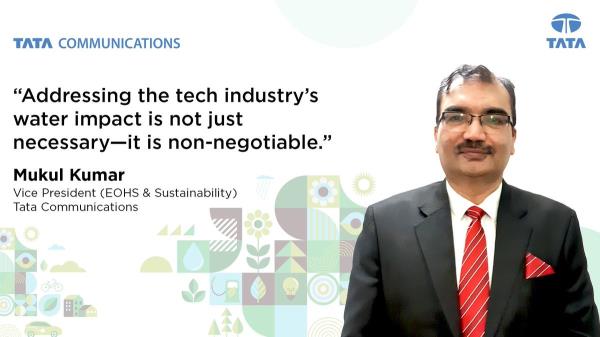23 May 2025
Mukul Kumar, Vice President (EOHS & Sustainability), Tata Communications
Centuries ago, civilisations began settling along riverbanks as there was a steady source of water and the land was fertile for cultivation.
Today, we have come full circle as industries and urban centres are increasingly prioritising locations with sustainable water access due to rising resource pressures. All institutions —commercial or residential — are prioritising locations with reliable water access. However, such requirements underscore the immense pressure industries place on water resources. Industries such as agriculture, manufacturing (textiles, pulp and paper, chemicals), power generation and construction— alongside the tech sector— are among the largest consumers of water, further exacerbating the crisis. A holistic approach is required to ensure sustainable water management across these key sectors.
The technology sector in particular, data centers and semiconductor manufacturing, require substantial amounts of water primarily for cooling servers and IT equipment, as well as for processes like cleaning and rinsing during manufacturing. Technological advancements like AI today have raised concerns on water scarcity and sustainability, because of the significant power and water-based colling systems needed. To put it in context, the global AI demand is projected to account for 4.2-6.6 billion cubic meters of water withdrawal in 2027, which is more than the total annual water withdrawal of half of the United Kingdom! This poses a serious question: Are government and corporate efforts sufficient to ensure water conservation in a country like India, home to nearly 1.5 billion people?
Tech Dilemma: Balancing act of progression and preservation
Behind the modern data centres and cutting-edge manufacturing facilities lies a large, seldom overlooked water footprint. According to an S&P Global report, semiconductor factories depend on water to cool systems and consume as much water as Hong Kong, a city of 7.5 million.
The real challenge for the tech sector is not just keeping up with domain advancements but proactively anticipating future sustainability needs, particularly water consumption. In countries like India, where water scarcity is already severe, unchecked demand from the tech sector risks further straining fragile resources. Reports project that India’s Silicon Valley- Bengaluru, alone is likely to face a worrying water crisis this summer with groundwater levels predicted to drop dangerously low. The population of Bangalore has also tripled since 1990, ever since it transformed into a leading tech hub. This growth has drained the city’s natural resources, impacting the city’s water bodies and land is also cleared for urbanisation.
However, water consumption is only one part of the equation and managing wastewater is equally critical. Improper discharge from data centers, chip fabrication plants, and manufacturing units contaminate local water supplies, leading to severe environmental degradation.
Reports indicate that semiconductor fabrication plants alone produce up to 15 million litres of wastewater per day.
Without stringent treatment and recycling measures, wastewater can release hazardous chemicals such as heavy metals and volatile organic compounds into the ecosystem, exacerbating water crises in vulnerable regions and for an industry that prides itself on innovating technologies to solve global challenges, addressing its own water impact is not just necessary—it is non-negotiable.
At Tata Communications, climate change is one of our key priorities. The Nanneer project was one such project where we focused on the rejuvenation and restoration of Nagan Thangal Lake for effective groundwater recharge in Thiruvallur District, near Chennai. We rejuvenated a neglected waterbody, tackling pollution, water scarcity, and biodiversity loss, directly benefiting over 4,000 residents and indirectly impacting over 18,000, thereby promoting a sustainable and inclusive approach.
Tech reimagined: New technologies define the future
Emerging technologies such as IoT, AI, and cloud-based analytics are transforming water management, enabling companies to monitor, optimise, and reduce consumption real time. For instance, leading enterprises are integrating AI-driven water optimisation models and IoT-based predictive analytics into their operations to enhance water efficiency. Smart sensors, powered by IoT, detect leaks instantly and prevent unnecessary wastage. AI-driven predictive analytics can also analyse consumption patterns and optimise water usage, helping organisations proactively manage their resources. Additionally, advanced cooling systems, such as liquid immersion cooling for data centres, significantly reduce water dependency compared to traditional cooling methods. Leading semiconductor manufacturers, are also implementing large-scale water recycling and zero-liquid discharge (ZLD) systems to minimise their environmental impact. Semiconductor manufacturers, for example, are increasingly adopting closed-loop water recycling technologies that recover and reuse up to 90% of wastewater. These closed-loop systems work by continuously treating wastewater and reintroducing it into the production cycle, drastically reducing freshwater intake. Such innovations not only reduce freshwater dependency but also set industry benchmarks for responsible water stewardship.
Meanwhile, rainwater harvesting, a time-tested method of water conservation, is being integrated into modern industrial ecosystems. Companies are leveraging AI-driven systems to enhance rainwater collection efficiency, ensuring maximum storage and utilisation. Indian enterprises are deploying AI-powered rainwater harvesting systems to maximise water conservation. By combining traditional conservation methods with cutting-edge technology, the tech industry is demonstrating that sustainability is not just an obligation but an opportunity for long-term progress and resilience.
At Tata Communications, through one of our initiatives, Vitalize Rural we raised awareness on the impact on water conservation, climate-resilient agriculture, and livelihood development. We tackled critical environmental and livelihood challenges across an area of 3,801 hectares in Dharashiv, Maharashtra, positively impacting over 5,500 lives in four villages through improving soil moisture, enhancing water availability, promoting climate-resilient agriculture, and supporting marginalised families towards a sustainable livelihood.
Tech Connect: Collaborate and Commit
Water preservation extends beyond corporate boundaries. Tech companies are increasingly collaborating with governments, NGOs, and local communities to drive larger impact. Initiatives such as restoring lakes, rejuvenating river basins, and implementing water-efficient farming techniques have transformed water-stressed regions. These collaborative efforts improve water availability and foster stronger ties between industries and the communities they serve.
However, adopting sustainable water solutions comes with economic challenges. Advanced water recycling systems like ZLD are costly and energy-intensive, making them feasible only for select facilities. For smaller companies, financial constraints may hinder large-scale adoption. ZLD processes also require significant energy inputs for evaporative treatments, making them more suitable for large enterprises with the necessary resources. A balanced approach that includes government incentives, subsidies, and shared infrastructure models can encourage broader participation in water sustainability initiatives.
The way forward requires a shared commitment to responsible stewardship and a multi-faceted approach i.e. reducing consumption, enhancing water efficiency and embedding regenerative practices into daily operations. With bold commitments by technology companies to achieve up to 20% or more reduction in water usage in the near future, the industry can set new standards for environmental accountability. Industry alliances, forums, cross-sector partnerships and such collective efforts can help tech companies exchange insights, set benchmarks, and drive large-scale impact.
Now is the time to act. The world is watching, and India’s burgeoning tech industry has the talent, resources, and tenacity to drive the digital revolution while simultaneously protecting the world’s most precious resource: water.






